|
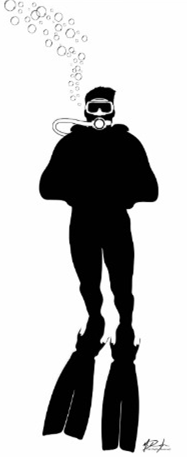

Dive Log
Back to

Back to

|
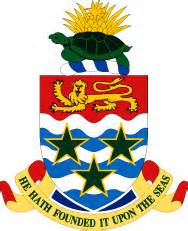
Cayman Brac &
Little Cayman, British West Indies
June, 1986
I've learned two truisms in life.
One is you can never go back and shouldn't even try, and second
is that sooner or alter your luck will run out. These both
came true in 1986 when we chose to return to the Cayman Islands;
this year staying at Cayman Brac (Bluff). From start to
finish, one thing after another made the trip somewhat less than
ideal. But it was still pretty damn good.
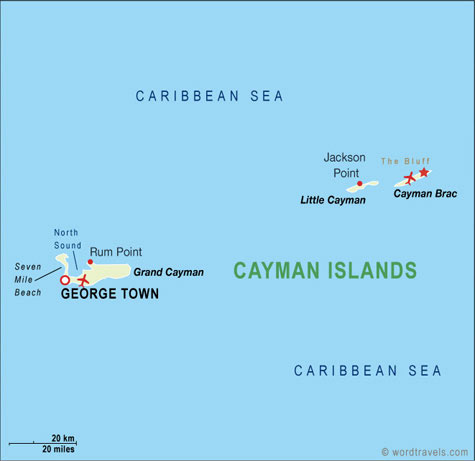 |
A bit of history...
Christopher Columbus sighted Cayman
Brac and its sister island, Little Cayman, on 10 May
1503 when his ship was blown off course during a trip
between Hispaniola and Panama. He named them "Las
Tortugas" because of the many turtles he spotted on the
islands. The Cayman Islands were renamed by Sir Francis
Drake, who came upon the islands during a voyage in
1586. He used the word "Caymanas", taken from the Carib
name for crocodiles after seeing many of the large
crocodilians. Many people believe he had only seen the
Rock Iguanas that inhabit the island today.
During the heyday of piracy,
pirates would use Cayman Brac as a haven and a place to
replenish their supplies as there are a number of fresh
water wells on the island and had many sources of food
included in the local flora and fauna.
The first settlement on Little
Cayman was in the 17th century, when turtle fishermen
set up camps. After a raid by a Spanish privateer, the
settlements were abandoned in 1671 and the island was
not resettled until 1833, when Blossom Village
was established by a few families. By the early 20th
century, a few hundred people lived on Little Cayman and
exported phosphate ore, coconuts, and marine rope.
|
Our flight would take us from Omaha to
Chicago to Miami and then on to Grand Cayman; a route we would
never take again on an airline we would never use again.
Upon arrival in Chicago, we were informed that due to weather
and the fact that the pilot was over his scheduled flight time,
our flight to Miami was delayed several hours and our flight
from Miami to Grand Cayman would put us in too late to fly over
to Cayman Brac as scheduled.
In Miami, Customer Services rearranged our
flight and gave us the name of a hotel near the airport to
overnight. The airline would of course pick up the tab -
bull shit!. They later paid for the night's lodging but
not the taxi fate, meals, or make any reparations for the loss
of a day of diving. We flew into Grand Cayman expecting to
see the asphalt runway and brick and tin airport of six years
ago. What we flew into was a million dollar international
airport with a beautiful modern A-frame lobby with marble floors
and attached shops of fine gifts. Obviously casinos and
the island economy was doing well. In the lobby on a black
marble column under a security-protected case was a beautiful
trophy for marlin fishing. The trophy was of a blue marlin
breaking water. It was about three feet tall and was so
realistic that we had to check to see if it wasn't a taxidermy
mount. It was a work of art.
We rented a taxi and paid for the hotel
room that the airline said they would pre-pay for the
inconvenience, and spent the night in a dingy room with a loud
air conditioner. The following morning we returned to the
airport to connect with our flight over to Cayman Brac. We
were flown in a small Cesna over to the island and landed on the
more typical gravel runway with a single hut as the airport -
that's the Cayman Islands we remembered. One difference,
there was a large bump/rise in the middle of the airstrip.
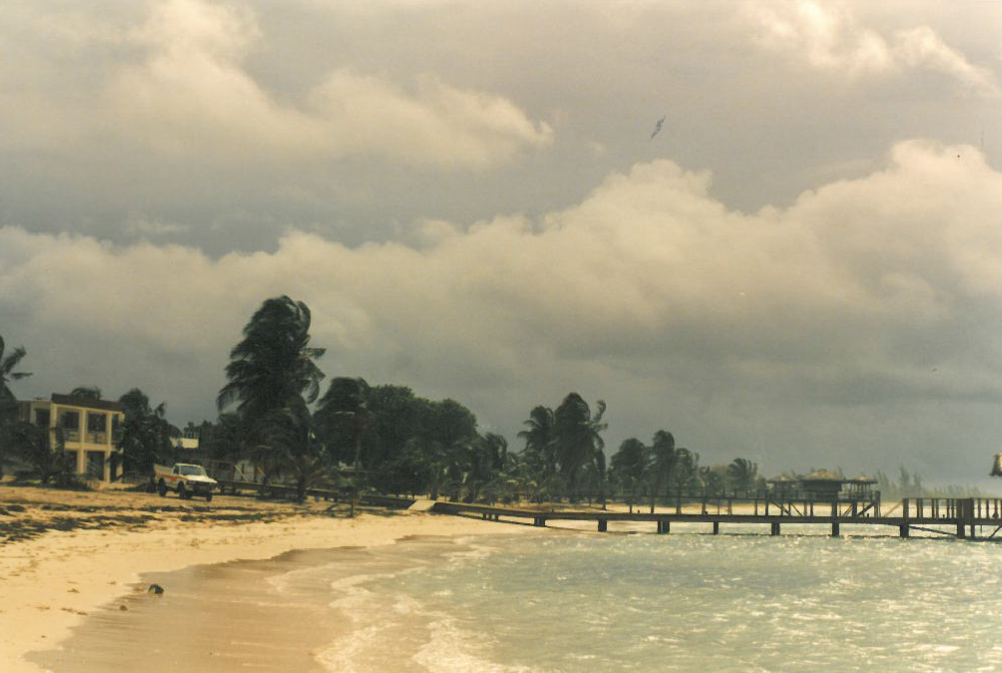 |
We
stayed at the Tiara Beach Hotel (now closed and
abandoned). Our room was right on the beach next
to the boardwalk leading to the dive shop and boats.
The room was pleasant enough but generic - single
bedroom, two beds, shower, and a small closet. We
did have an air conditioner and of course there was the
ever-present ceiling fan. A print of a tropical
island adorned one wall, windows with glass shutters
covered two walls. We were situated next to the
tennis court and the dive shop was next to that.
The dining area was on the other side of the tennis
court facing the ocean. Confused?
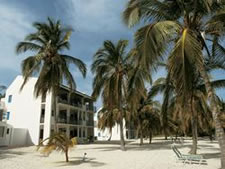 |
After checking in and shuffling our gear
to the dive shop, we signed up for the checkout dive at "Radar
Reef." The weather had been playing havoc with the diving
creating waves too rough to dive the usual hot spots. It
was rainy and windy every day we were there save one. So
much for our luck with the weather. What was surprising
was how clear the water was in spite of the poor weather and
rough conditions. But along with the storms came pressure
centers and headaches to match. The first dive became a
battle to clear my ears. When the battle was over, I had a
new battle with clearing my mask - a problem that plagued me for
as long as I dove.
Well, not the best way to start but there
we were and we were going to make the best of it. The dive
shop and employees did everything in their power to make us feel
welcome in spite of everything that had happened and were as
tired of the weather as we were. The air temp and water
were about the same, 65-70 degrees.
The meals at Tiara were excellent and
little can be said about the dining here that hasn't already
been said about the other islands already. It was
typically American favorites for lunch and for dinner it was
more "islandized" with meals like coconut grouper. We were
always served more food than we should have eaten.
Our next dive - "Duppy (Ghost) Reef" - was
a good example of cattle-boat diving. Somehow we managed
to run into another group of divers from Texas. At the
reef, it was a mass of people in a small area with divers
crawling over one another on and off the boat. The reef
wasn't anything spectacular other than it did have nice sea
fans. It was a shallow dive and we were in the water for
about an hour.
We did experience something on this island
that was new - drinks were free. As long as you drank
there at the hotel, there was no charge or limit on what you
drank. We drank a lot of banana daiquiris and beer.
If you wanted a beer on the dive boat, then you had to pay.
We occasionally broke with tradition and had a beer on the boat,
but not very often.
Along with the overcast conditions, we
were plagued with another condition - no-see-ums. The
scientific name for the no see um is Ceratopogonidae,
but it has accumulated many common names. These include the
sand flea, sand fly, biting midge and
punkie or punky. The insect is a bloodsucker many
times smaller than a mosquito, but with a bite inversely more
painful. The sting causes a large welt that can irritate the
skin for several days, causing severe itching. It is tiny enough
to pass through window screens, making it a nuisance. We
ran into them on other islands but not to this extreme.
Some divers combat them with OFF or Cutters and others use an
Avon product called Skin-So-Soft. Anything helps but
nothing works completely. Fortunately, they prefer the
shade. Unfortunately, it was always cloudy so always
shady.
"Radar Reef" was a pleasant dive along the
communications cable that runs from Cayman Brac over to Grand
Cayman. "Cemetery Wall" was a nice wall dive where we
entered the wall at 90 feet and dove through the wall towards
the surface. The weather was still overcast with
occasional showers and the water conditions were rough.
The major difficulty in rolling seas is getting in and out of
the dive boat. For the boat's pilot, the challenge was to
run the boat through the surf among the shallow reefs for
anchoring.
"Kissame Reef" was named after a sunken
tugboat that sits on its starboard side in the sand. It
was a nice dive for nudibranchs and skates. For once, the
conditions were calm but still cloudy.
|
A bit of information...
A nudibranch is
a member of the Nudibranchia, a group of soft-bodied, marine
gastropod mollusks which shed their shells after their larval
stage.They are noted for their often extraordinary colors and
striking forms. Currently, about 2,300 valid species of
nudibranchs are known. Nudibranchs are often casually
called sea slugs, but many sea slugs belong to several taxonomic
groups which are not closely related to nudibranchs.

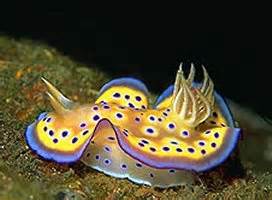

Skates are
cartilaginous fish belonging to the family Rajidae in the
superorder Batoidea of rays.
 |
That evening during
dinner, we were entertained by the children of South Bay Primary
School. They were dressed in traditional costume and sang
familiar songs like "Sloop John B." and "Lemmon Tree." It
was very entertaining.
"The Shoots" on east
Cayman Brac was appropriately named. A beautiful wall to
dive, but swimming against the current sucked up a lot of air.
On the return trip we shot by the wall.
|
"Patch Reef" was
a deep wall dive where we saw large schools of black
durgeons - a beautiful but aggressive fish. It
propels itself through the water effortlessly with
continuous dorsal and ventral fins. They are coal
black in color with the exception of a thin neon blue
line where the fins meet the body. A few more fish
descriptions...
|
Cow Fish and Trunk Fish are
odd creatures. Both have a
triangular-shaped body and small fins that are
constantly moving. The cow fish is so
named because of the appendages on its head that
resemble horns.
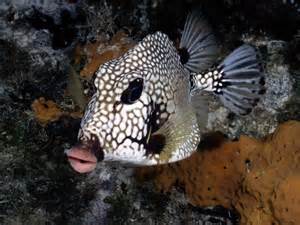 |
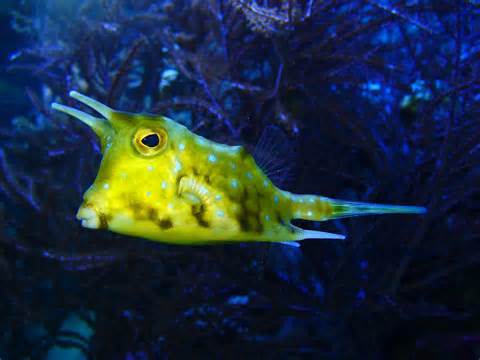
The trumpet fish also vary in
color depending on the surroundings. A
long flat file-shaped fish with a narrow head
and small mouth, these predators hang vertically
among the sea grass and fans awaiting their
prey.
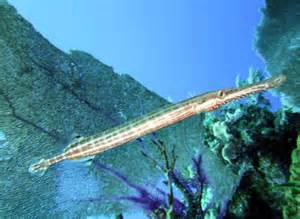 |
|
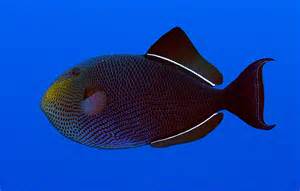
Anemones look like giant gummy worms.
Varying in color from yellow to green to purple, they
look like a clump of baseball bats stuck together with
their handles sticking up. At the slightest touch,
they retract.
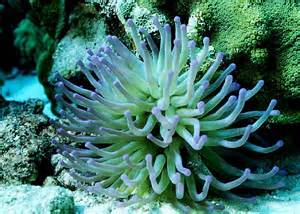 |
On June 6th we dove "End of Island Reef" -
a shallow dive with pillar coral formations. There were
large schools of grunts, butterfly fish, wrasse, parrot fish,
rock beauties, etc. The weather was still overcast, windy,
and a cool 65 degrees. That evening we were to make a
night dive at "Buccaneer Reef." Those who chose to go met
at the dive shop at 7:30. Included was a father and
daughter who we struck up a conversation with on the trip to the
dive site. The daughter had dove with Jacque Cousteau and
the crew of the Calypso. It was part of a youth
oceanography program. She was not impressed and it was her
feeling that they were not safe divers. The French have a
system of bobbing up and down at different depths and used a
completely different set of tables than in the United States.
The night was overcast which made gearing
up difficult and Dad was frustrated to the point of telling me
to go on without him. I said there wasn't any hurry and
the others wouldn't get too far ahead of us. Surface
conditions were calm but walking over boulders to the water in
full gear was difficult and tiring. We did see numerous
rays, large crabs, several eels, and basket stars as well as a
small octopus that was rescued from a crab by one of the divers.
It lost one tentacle but it was a small price to pay for the
rescue. After the ordeal, it seemed willing to let the
divers hold and pet it. I ran out of air early, which was
strange for me. Since I didn't have a night light, I
signaled my return to the beach and crawled my way back.
Our last day of diving, THE SUN CAME OUT.
With the change in weather and surface conditions, it was
determined that we could make a dive on Little Cayman - the
third island in the chain. The boat ride was going to be
long so the cooler was packed and we left at 9 AM. Little
Cayman is about the size of Cayman Brac but not nearly as
populated - the island terrain is more rugged. Actor
Burgess Meredith had a house on the island at the time.
The island may have been nondescript but the diving was anything
but.
 |
"Bloody
Bay Wall" was renowned as one of the world's finest wall
dives, and I can certainly understand why.
Pristine waters with unlimited visibility and a vertical
wall dropping off to what seemed infinity. No
litter, no current, extremely clean fans and sponges in
every color imaginable. Enormous anemones and
large schools of fish made this dive one of our most
memorable. Among the divers was the hotel's
photographer taking plenty of individual and group
photos. They presented a slide show that evening
where we could purchase copes, which we did.
That afternoon, we made our last dive
for the trip at "Fantastic Reef" on Little Cayman.
And it was fantastic. A clean shallow reef dive,
we spent a large amount of time in a clearing that
seemed to attract large schools of fish and some larger
fish including a grouper that you could pet if so
inclined. Off to the deeper side of the wall was a
pair of spotted eagle rays that probably had a 20 foot
wing span. There were Queen Conch alive and
littering the sands everywhere. Majestic angel
fish with their gold-trimmed scales and eyes, and a
large barracuda smiling pretty for the photographer.
The fish and coral all seemed brighter and bigger than
anywhere else. |
All in all, Little Cayman and Cayman Brac
were both excellent dive islands and the Tiara Beach Hotel was a
comfortable and hospitable stay. The dive operation was
top notch and the food was excellent. If it hadn't been
for the weather, the trip might have been ideal.
But, fate wasn't finished with us yet.
We paid our fee to leave the island, went through customers, and
retraced our flight back to Chicago. We went through
customs there and ran to catch our connecting flight.
There was no need to hurry, the flight had been delayed six
hours due to fog.
Back to

Back to

|